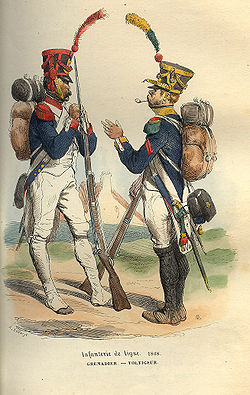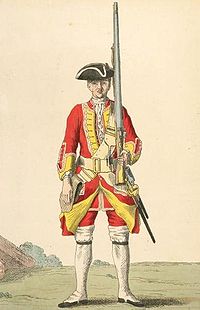
Facing colour
Encyclopedia

Europe
Europe is, by convention, one of the world's seven continents. Comprising the westernmost peninsula of Eurasia, Europe is generally 'divided' from Asia to its east by the watershed divides of the Ural and Caucasus Mountains, the Ural River, the Caspian and Black Seas, and the waterways connecting...
an uniform
Uniform
A uniform is a set of standard clothing worn by members of an organization while participating in that organization's activity. Modern uniforms are worn by armed forces and paramilitary organizations such as police, emergency services, security guards, in some workplaces and schools and by inmates...
military tailoring technique where the lining
Lining (sewing)
In sewing and tailoring, a lining is an inner layer of fabric, fur, or other material inserted into clothing, hats, luggage, curtains, handbags and similar items....
of the standard military jacket visible to the observer is of a different colour to that of the jacket
Jacket
A jacket is a hip- or waist-length garment for the upper body. A jacket typically has sleeves, and fastens in the front. A jacket is generally lighter, tighter-fitting, and less insulating than a coat, which is outerwear...
. The jacket lining evolved to be of different coloured material, then of specific hue
Hue
Hue is one of the main properties of a color, defined technically , as "the degree to which a stimulus can be describedas similar to or different from stimuli that are described as red, green, blue, and yellow,"...
s. Accordingly when the material was turned back on itself: the cuffs, lapels and tail
Tail
The tail is the section at the rear end of an animal's body; in general, the term refers to a distinct, flexible appendage to the torso. It is the part of the body that corresponds roughly to the sacrum and coccyx in mammals, reptiles, and birds...
s of the jacket exposed the contrasting colours of the lining or facings, enabling ready visual distinction of units: regiments, divisions
Division (military)
A division is a large military unit or formation usually consisting of between 10,000 and 20,000 soldiers. In most armies, a division is composed of several regiments or brigades, and in turn several divisions typically make up a corps...
or battalions each with their own specific and prominent colours. It was especially observed and elaborated on during the Napoleonic Wars
Napoleonic Wars
The Napoleonic Wars were a series of wars declared against Napoleon's French Empire by opposing coalitions that ran from 1803 to 1815. As a continuation of the wars sparked by the French Revolution of 1789, they revolutionised European armies and played out on an unprecedented scale, mainly due to...
.
Great Britain

Red coat (British army)
Red coat or Redcoat is a historical term used to refer to soldiers of the British Army because of the red uniforms formerly worn by the majority of regiments. From the late 17th century to the early 20th century, the uniform of most British soldiers, , included a madder red coat or coatee...
") worn by British infantry
Infantry
Infantrymen are soldiers who are specifically trained for the role of fighting on foot to engage the enemy face to face and have historically borne the brunt of the casualties of combat in wars. As the oldest branch of combat arms, they are the backbone of armies...
soldiers made it difficult to distinguish between units when engaged in battle. The use of Colours assisted soldiers in rallying on a common point, and each Regiment
Regiment
A regiment is a major tactical military unit, composed of variable numbers of batteries, squadrons or battalions, commanded by a colonel or lieutenant colonel...
had a flag, or Colour, in a specific shade so as to be easily distinguished. The lining of uniform jackets came to be made from material of the same regimental colours, and when the material was turned back, in the cuffs, lapels and tails of the jacket, the lining, or "facing" was exposed. Facings came to be used by most of the other western armies during the late 17th and early 18th century periods.
The tradition of associating particular colours with specific Regiments continued into the 20th century, even when the use of red jackets ceased in favour of khaki. These facings remained a part of ceremonial uniforms, and the practice was adopted by Commonwealth
Commonwealth of Nations
The Commonwealth of Nations, normally referred to as the Commonwealth and formerly known as the British Commonwealth, is an intergovernmental organisation of fifty-four independent member states...
military units that adopted dress distinctions from affiliated units of the British Army
British Army
The British Army is the land warfare branch of Her Majesty's Armed Forces in the United Kingdom. It came into being with the unification of the Kingdom of England and Scotland into the Kingdom of Great Britain in 1707. The new British Army incorporated Regiments that had already existed in England...
.
In 1881 an attempt was made as an economy measure to standardise facing colours for British infantry regiments (other than the 4 rifle regiments who wore dark green uniforms) according to the following system:
- Guards and "Royal" Regiments (i.e. those with "Royal", "King's", "Queen's" or Prince Albert's name in the title) - Dark Blue.
- English & Welsh Regiments - White.
- Scots Regiments - Yellow.
- Irish Regiments - Green (In fact this meant only the Connaught Rangers. All other Irish Regiments were "Royal" and so had dark blue facings).
While this standardisation made the manufacturing and replacement of uniforms simpler, it proved unpopular amongst the army at large. Some regiments (e.g. The Buffs and Green Howards) derived their names or nicknames from the colour of their facings and the Duke of Wellington's Regiment (who had red facings) lost their claim to be the only truly red coated regiment in the British Army.
So widespread was opposition to the order, and so frequent the requests for special exceptions to be made, that the scheme in its original form was finally dropped and the historic colours were re-instated in a number of regiments, until full dress for the Army as a whole finally vanished with the coming of war in 1914. While many regiments did continue with their new 1881 facings, instances where reversion to traditional colours was approved included the Northumberland Fusiliers (white to Gosling green), the Manchester Regiment (white to Lincoln green), the Norfolk Regiment (white to yellow), the Essex Regiment (white to 'Pompadour Purple'), the Devonshire Regiment (white to Lincoln green), the Highland Light Infantry (yellow to buff), the Seaforth Highlanders (yellow to buff), the Prince of Wales's Own Yorkshire Regiment (white to grass green), the Duke of Wellington's Regiment (white to scarlet), the Duke of Edinburgh's Wiltshire Regiment (white to buff), the Suffolk Regiment (white to yellow), the Durham Light Infantry (white to dark green) and the Buffs (white to buff). Even after World War I this tendency to revert to historic facings continued, although by that time the scarlet uniforms were normally worn only by regimental bands and by officers in mess and levee dress. As examples the Norfolk Regiment regained its former yellow facings in 1925 and the North Staffordshire Regiment its pre-1881 black facings in 1937.
France
During the Ancien Régime, there were many different facing colours (notably various shades of blue, red, yellow, green and black) on the standard grey-white uniforms of the French line infantry . Examples included blue for the Régiment du LanguedocLanguedoc
Languedoc is a former province of France, now continued in the modern-day régions of Languedoc-Roussillon and Midi-Pyrénées in the south of France, and whose capital city was Toulouse, now in Midi-Pyrénées. It had an area of approximately 42,700 km² .-Geographical Extent:The traditional...
, red for the Régiment du Béarn
Béarn
Béarn is one of the traditional provinces of France, located in the Pyrenees mountains and in the plain at their feet, in southwest France. Along with the three Basque provinces of Soule, Lower Navarre, and Labourd, the principality of Bidache, as well as small parts of Gascony, it forms in the...
etc. This tendency towards varigated facings reached its height in the "Dress Regulation Facings for the Army" of 31 May 1776 when unusual shades such as silver-grey, aurore and "red speckled with white" were added to the by-then white uniforms of the French infantry .
The rise of mass conscript armies during and following the Napoleonic Wars
Napoleonic Wars
The Napoleonic Wars were a series of wars declared against Napoleon's French Empire by opposing coalitions that ran from 1803 to 1815. As a continuation of the wars sparked by the French Revolution of 1789, they revolutionised European armies and played out on an unprecedented scale, mainly due to...
led to increasing standardisation of facing colours, for reasons both of economy and supply efficiency. Thus, for example, the French line fusilier
Fusilier
Fusilier was originally the name of a soldier armed with a light flintlock musket called the fusil. The word was first used around 1680, and has later developed into a regimental designation.-History:...
s and grenadiers of the early 19th century had red facings, with only numbers to distinguish one regiment from another. The voltigeurs had yellow or/and green facings. From 1854 on red facings became universal for all of the line infantry who made up the bulk of the French metropolitan Army, although the Chasseurs, who constituted a separate branch, retained yellow facings as a special distinction.
Other armies
The practice of using facing colours to distinguish individual regiments had been widespread in European armies in the 18th century when such decisions were largely left to commanding officers.By the second half of the nineteenth century, the Dutch, Spanish, Swiss, Belgian, Japanese, Portuguese, Italian, Romanian, Swedish, Greek and Turkish armies had come to follow French standardised arrangements, although some variety might be ensured by the existence of different categories of infantry within a particular army, each with its own uniform and facings. As a general rule cavalry tended to be more variegated and it was not uncommon for each mounted regiment to retain its own facings colours up to 1914.
The United States regular army after the American Civil War
American Civil War
The American Civil War was a civil war fought in the United States of America. In response to the election of Abraham Lincoln as President of the United States, 11 southern slave states declared their secession from the United States and formed the Confederate States of America ; the other 25...
adopted a universal dark and light blue uniform under which each regiment was distinguished only by numbers and other insignia, plus branch colors. The latter were yellow for Cavalry, red for Artillery and white (later light blue) for infantry. Combinations of colors such as scarlet piped with white for Engineers, orange piped with white for the Signal Corps and black piped with scarlet for Ordnance personnel gave wide scope for adding distinctive branch facings as the Army became more technical and diverse. This system continued in general use until blue uniforms ceased to be general issue in 1917, and survives in a limited form in modern blue mess and dress uniforms.
Notable exceptions to such standardisation within branchs were the British Army (as noted above) and the Austro-Hungarian one. As late as World War I the latter employed 28 different colours, including 10 different shades of red, for its infantry facings.
In the very large Imperial German and Russian armies infantry, facing colours were often allocated according to the position that a particular regiment held in the order of battle - that is within a brigade, division or corps. As an example, amongst the Russian line infantry, the two brigades within each division were distinguished by red or blue shoulder straps; while the four regiments within each division wore red, blue, white or green collar patches and cap bands respectively.

